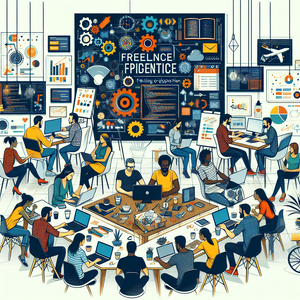The Rise of Remote Web Development: How to Thrive in a Virtual Workspace

The journey to widespread remote work began long before the pandemic. However, it was during this period that many companies recognized the potential of a distributed workforce. Web development, which inherently relies on technology and communication tools, is one of the sectors that has embraced this shift most enthusiastically. The flexibility of working from home has attracted talent from around the globe, allowing companies to tap into a diverse pool of skills and perspectives. As a result, job postings for remote web developer positions have surged, reflecting a growing acceptance of this mode of operation among both employers and employees.
Advantages of Remote Web Development
Remote work offers developers the freedom to create their own schedules. This flexibility can lead to increased job satisfaction and productivity, as individuals can work during their most productive hours, whether early in the morning or late at night. For instance, a developer with a preference for late-night coding sessions can capitalize on this natural rhythm, leading to higher-quality work.
Cost Savings
Both employers and employees can save money. Companies can reduce overhead costs associated with physical office spaces, while developers can save on commuting expenses and time. A study by Buffer indicated that 98% of remote workers would like to work remotely at least some of the time for the rest of their careers, largely driven by the financial benefits associated with remote work.
Global Opportunities
The remote nature of web development jobs means that developers can seek employment with companies from different regions or even countries. This opens doors to unique projects and experiences that may not be available locally. For instance, a web developer in India can work with a startup in Silicon Valley, gaining insights into global market trends and innovative practices.
Challenges of Remote Work
While the benefits of remote work are compelling, there are challenges that need to be addressed to thrive in a virtual workspace.
Isolation
One of the biggest struggles for remote developers is the lack of social interaction. Working from home can lead to feelings of loneliness and disconnection from colleagues. To combat this, developers should actively seek virtual social interactions, whether through team meetings, online forums, or informal catch-ups. Platforms like Discord or Slack can foster community-building among remote teams.
Distractions at Home
The home environment can be filled with distractions, from household chores to family members. Establishing a dedicated workspace and setting clear boundaries with family or roommates can help minimize interruptions. Techniques like the Pomodoro Technique, which promotes focused work sessions followed by short breaks, can also enhance concentration.
Communication Barriers
Remote work relies heavily on digital communication, which can sometimes lead to misunderstandings. Developers should prioritize clear and concise communication, utilizing tools like Slack, Zoom, or Microsoft Teams to facilitate collaboration. Regular check-ins and updates can help ensure that everyone is aligned and reduce the chances of miscommunication.
Tips for Maintaining Productivity
Establishing a daily routine can help create a sense of structure. Choose specific working hours and stick to them, incorporating regular breaks to recharge. For instance, starting the day with a morning routine and a clear plan can set a positive tone for productivity.
Leverage Collaboration Tools
Utilize project management tools like Trello or Asana to keep track of tasks and deadlines. Version control systems like Git can streamline collaboration on coding projects, making it easier for teams to work together despite being physically apart.
Create an Inspiring Workspace
Design a workspace that promotes focus and creativity. Invest in ergonomic furniture, good lighting, and decor that inspires you. A comfortable environment can significantly impact productivity. Personalizing your workspace with motivational quotes or artwork can enhance your mental well-being while working.
The rise of remote web development has transformed the way developers work and interact with their teams. While it presents unique challenges, the opportunities for flexibility, cost savings, and global engagement make it an attractive option for many. By implementing effective strategies to enhance productivity and communication, web developers can not only thrive in a virtual workspace but also enjoy a more balanced and fulfilling professional life. As this trend continues to evolve, embracing the remote work culture will likely be key to success in the web development field. The future of web development is undoubtedly remote, and those who adapt will find themselves at the forefront of this exciting evolution.
Remote Front-End Developer
GitHub, Shopify, remote-first startups
Core Responsibilities
Design and implement user interfaces using HTML, CSS, and JavaScript to enhance user experience and engagement.
Collaborate with UX/UI designers to ensure responsive and visually appealing designs across various devices.
Optimize web applications for maximum speed and scalability, debugging and troubleshooting as needed.
Required Skills
Proficiency in front-end frameworks like React, Angular, or Vue.js.
Strong understanding of web performance optimization techniques and accessibility standards.
Experience with version control systems, particularly Git.
Remote Full-Stack Developer
Automattic, Basecamp, Buffer
Core Responsibilities
Build and maintain both client and server-side applications, ensuring seamless integration between front-end and back-end systems.
Design RESTful APIs and manage databases, ensuring data integrity and security.
Participate in code reviews and contribute to team knowledge sharing through documentation and best practices.
Required Skills
Proficiency in multiple programming languages, such as JavaScript (Node.js), Python, or Ruby.
Familiarity with database management systems like MongoDB or PostgreSQL.
Strong problem-solving skills and ability to work collaboratively in a remote team environment.
Remote DevOps Engineer
Amazon, Google, smaller agile companies
Core Responsibilities
Design and implement CI/CD pipelines to automate deployment processes and improve software delivery.
Monitor system performance and troubleshoot issues across various environments, ensuring reliability and uptime.
Collaborate with development teams to integrate development and operations, promoting a culture of continuous improvement.
Required Skills
Expertise in cloud platforms such as AWS, Azure, or Google Cloud.
Proficiency in scripting languages like Python, Bash, or Ruby for automation tasks.
Familiarity with containerization tools like Docker and orchestration platforms like Kubernetes.
Remote UX/UI Designer
Airbnb, Slack, design agencies
Core Responsibilities
Conduct user research and usability testing to gather insights and inform design decisions.
Create wireframes, prototypes, and high-fidelity mockups to communicate design concepts effectively.
Collaborate with developers to ensure the final product aligns with design specifications and user needs.
Required Skills
Proficiency in design tools like Sketch, Adobe XD, or Figma.
Strong understanding of user-centered design principles and accessibility standards.
Excellent communication skills to articulate design concepts and gather feedback from stakeholders.
Remote JavaScript Developer (Specializing in Node.js)
DigitalOcean, Trello, Heroku
Core Responsibilities
Develop server-side applications using Node.js, ensuring efficient and scalable backend solutions.
Collaborate with front-end developers to integrate APIs and optimize application performance.
Write unit and integration tests to ensure code reliability and maintainability.
Required Skills
Strong proficiency in JavaScript, particularly in asynchronous programming and event-driven architecture.
Experience with frameworks like Express.js and knowledge of NoSQL databases such as MongoDB.
Familiarity with RESTful services and API design principles.


